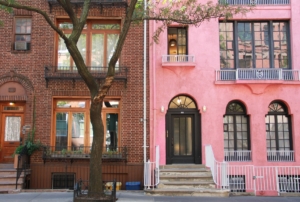Key Takeaways:
- Three in five Gen Z renters in the US are considered rent-burdened, spending more than 30% of their income on housing costs.
- San Diego, Los Angeles, and Sacramento are the three markets with the nation’s highest shares of rent-burdened Gen Z renters.
- In most large metros in the South, Gen Z renters are more likely to be rent-burdened than Millennials coming of age 10 years ago.
- New York City remains one of the nation’s most unaffordable rental markets, with two in three Gen Z renters being rent-burdened — about the same as Millennials coming of age 10 years ago.
As Gen Z renters march further into adulthood, they face a challenging housing market. The sharp labor market recovery since the pandemic led to rising wages, but soaring demand for rentals and limited inventory has led to even faster growth in rents. Across the United States, asking rents have grown 1.5x faster than wages since 2019, according to a recent analysis by Zillow® and StreetEasy®. In New York City, rents grew 7.4x faster than wages last year — the largest gap in the nation.
The spike in rent growth has made it difficult for young adults to keep housing costs, including rents and utilities, below 30% of their gross income — the threshold for being rent-burdened as used by the U.S. Department of Housing and Urban Development. Nearly three in five (58.2%) adult Gen Z renters (ages 18 to 25) in the US spend more than 30% of their income on housing costs and are considered rent-burdened, StreetEasy analysis of the U.S. Census Bureau’s American Community Survey (ACS) microdata shows.
High Rent Burdens on Younger Generations Is a National Problem
In each of the 30 largest metro areas throughout the US, at least half of Gen Z renters (between 18 and 25 years of age as of 2022) are rent-burdened. Even in Pittsburgh, the least rent-burdened metro area, half (49.8%) of Gen Z renters spent more than 30% of their income on gross rent in 2022.
San Diego and Los Angeles were the two metro areas with the nation’s highest shares of rent-burdened Gen Z-ers at 73.4% and 71.7%, respectively. Sacramento claimed the third spot, with 71% of Gen Z renters being rent-burdened. While the pace of rent growth has slowed recently, sky-high rents in these metros make it challenging to keep housing costs below 30% of income.
Just behind these top three were Florida metros Orlando, Miami, and Tampa. While gross rents in large Florida markets are lower than those in traditionally expensive Northeast metros, young adults’ typical income in Florida also tends to be lower than in the Northeast. For example, the median household income of Gen Z renters is $50,000 in Miami and $47,679 in Tampa. In the NYC area, the median household income of Gen Z renters is $60,000, netting out a lower share of income going to rent and utilities compared to Miami and Tampa.
High Rent Burdens on Young Adults Have Been a Decade-Long Issue
Following the Global Financial Crisis of 2008-9, steadily rising incomes led to gradual declines in the share of rent-burdened young adults. After peaking at 62% in 2011, the national share of rent-burdened young adults declined to 55% in 2019. However, surging renter demand since the pandemic has reversed this trend, with the share jumping to 58.6% by 2022. The historical undersupply of rental housing in the US has made it difficult for local markets to respond to surging demand, resulting in sharp rent increases.
While Millennials faced housing affordability challenges as they came of age, in 13 of the 30 largest metro areas, Gen Z renters in 2022 were more likely to be rent-burdened than Millennials were at the same age 10 years earlier. Many of these metros were in the South. For example, Gen Z adults in the Houston area were 1.2x more likely to be rent-burdened than Millennials coming of age a decade ago.
New York City Remains One of the Nation’s Most Unaffordable Cities
In New York City, one of the nation’s most expensive rental markets, two in three (65.6%) Gen Z renters were rent-burdened — the eighth highest share in the country. Individually, each of the city’s five boroughs has a higher share of rent-burdened Gen Z adults than at least 18 of the 30 largest metro areas nationwide.
Unlike other large cities, the share of rent-burdened young adults in NYC has remained consistently high. Two in three Gen Z renters are rent-burdened in NYC — about the same as Millennials coming of age in NYC 10 years ago. Layers of zoning regulations over the past 60 years have made it difficult for the city’s housing supply to catch up with surging demand. As a result, even during the recovery from the deep recession in 2008, the share of rent-burdened young adults has remained elevated.
Today, young adults in NYC face an especially challenging rental market. The strong labor market in 2022 and 2023 led to stronger growth in wages, but also grew demand for rentals. The rapid growth in asking rents on new leases has made it more challenging to keep housing costs below 30% of income, even as incomes rise.
Even high-income renters are struggling to find affordable housing. For instance, tech workers — whose wages are higher than average — could afford just one in three rentals on the market last year, according to StreetEasy research. The recent slowdown in hiring and rising unemployment in the NYC area will continue to squeeze the city’s young renters.
High rent burdens exacerbate housing instability and make it challenging to build wealth for long-term financial goals. Saving up for a down payment has become difficult for young adults, delaying their chances to become homeowners and start building equity.
Policy Recommendations to Address the Affordability Crisis
The growing housing shortage is the primary reason for the current affordability crisis. The nation’s housing deficit rose to 4.5 million in 2022, up from 4.3 million in 2021, according to Zillow analysis. Housing shortages are more severe in coastal cities such as San Diego, Los Angeles, and Boston, And these areas also saw the nation’s highest shares of Gen Z renters who are rent-burdened.
Zoning reforms to allow for more housing would be a step in the right direction. In New York City, StreetEasy analysis shows that targeted zoning reforms near public transit to allow modest increases in housing could unlock an opportunity to create up to 1.1 million new homes. Allowing additional housing will help maintain the vitality of neighborhoods by supporting a wide range of residents, from young professionals to seniors.
Removing red tape, such as minimum parking requirements, can make a difference in both developers’ ability to build new housing and renter affordability. Research shows that parking mandates add 17% to a unit’s annual rent across the nation. In NYC, constructing underground parking can cost $150,000 per space, leading to one unit of housing lost for every 1.2 parking spots, as estimated by Open Plans. The high cost of mandatory off-street parking thereby restricts affordable housing development.
The upfront costs of acquiring a rental can add up, with Zillow research showing those costs tend to be higher for renters of color. In New York City, upfront costs to move into an apartment average almost $10,500, with broker fees often being the largest expense. Lowering upfront costs will give all New Yorkers expanded choices in the rental market. Zillow and StreetEasy are advocating for broker fee reform to help lower the financial barrier to moving into an NYC rental.
Methodology
The estimates are based on StreetEasy analysis of the U.S. Census Bureau’s American Community Survey (ACS) microdata obtained from IPUMS USA, University of Minnesota. The Census Bureau defines a household as one or more people occupying the same housing unit. The individuals living together can be related or unrelated.
Following a rule of thumb by the U.S. Department of Housing and Urban Development, a household is considered rent-burdened if they spend more than 30% of gross household income on housing costs such as rent and utilities. For our analysis, we only considered adult renter households who reported paying rent and had positive income.
It is important to compare generations at similar stages of life for apple-to-apple comparison. To control for age, we calculated the share of rent-burdened households headed by young adults (ages 18 to 25) in each year between 2005 and 2022. We consider anyone born in or after 1997 as part of Generation Z. In 2022, the oldest Gen Z-ers were 25 years of age. The Millennial generation is widely considered to be anyone born before 1997 but after 1980.
StreetEasy is an assumed name of Zillow, Inc. which has a real estate brokerage license in all 50 states and D.C. See real estate licenses. StreetEasy does not intend to interfere with any agency agreement you may have with a real estate professional or solicit your business if you are already under contract to purchase or sell property. All data for uncited sources in this presentation has been sourced from Zillow data. Copyright © 2024 by Zillow, Inc. and/or its affiliates. All rights reserved.









